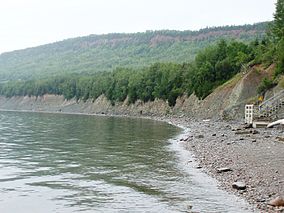- Miguasha National Park
-
Parc national de Miguasha IUCN Category III (Natural Monument)
Cliff of the Miguasha National ParkLocation Nouvelle, Avignon Regional County Municipality, Quebec, Canada Nearest city Dalhousie, New Brunswick Coordinates 48°06′38″N 66°22′10″W / 48.11056°N 66.36944°WCoordinates: 48°06′38″N 66°22′10″W / 48.11056°N 66.36944°W Area 87,3 ha Established 6 February 1985 Governing body SEPAQ Type: Natural Criteria: viii Designated: 1999 (23rd session) Reference #: 686 State Party:  Canada
CanadaRegion: Europe and North America Bothriolepis, a fossil antiarch placoderm found at this site.
 Reconstruction of Quebecius, a genus of porolepiform sarcopterygian fish from the Miguasha fossil site.
Reconstruction of Quebecius, a genus of porolepiform sarcopterygian fish from the Miguasha fossil site.
Miguasha National Park (French: Parc national de Miguasha) is a protected area near Carleton-sur-Mer on the Gaspé Peninsula of Quebec in Canada. Created in 1985 by the Government of Quebec, Miguasha was designated a World Heritage Site in 1999 in recognition of its wealth of fossils, which display a crucial time during the evolution of life on Earth. Other names for this site are the Miguasha Fossil Site, the Bay of Escuminac Fossil Site, the Upper Devonian Escuminac Formation, and the Hugh-Miller Cliffs. It is also sometimes referred to on fossil specimens as 'Scaumenac Bay' or 'Scaumenac Bay P.Q.'
Contents
Miguasha Natural History Museum
The park's museum features exhibits about the fossils and paleontology of the park. The museum's collection includes over 9000 specimens of fossil fish and plants.[1]
Physical description
The coastal cliffs are Upper Devonian strata of grey sedimentary rock. They are composed of alternating layers of sandstone and shale, which are 350–375 million years old. The area today supports mainly birch, aspen, and fir forests.
Palaeontological significance
Some of the fish, fauna, and spore fossils found at Miguasha are rare and ancient species. For example, Spermasposita is thought to be one of the oldest flowering plant[2] genera on Earth.[3]
Miguasha National Park is considered to be the world's greatest palaeontological record of fossils from the Devonian Period, known as the 'Age of Fishes'. Five of the six main fossil fish groups from this period (dating from 370 million years ago) can be found here. A great quantity of some of the best-preserved fossil specimens of lobe-finned fish, ancestors to the tetrapods (believed to be the first four-legged air-breathing terrestrial vertebrates), were found here.
History
The fossil site was first discovered in 1842, by Abraham Gesner (1797–1864), a geologist and medical doctor, and a pioneer in the petroleum industry.[citation needed] Gesner found a vast array of important fossils, which were handed over to the British Museum and the Royal Scottish Museum; these discoveries caused great excitement throughout the world. There was a rumour in the 1970s that some Americans were seeking to purchase the land containing the fossil deposits.[citation needed] In 1985 the Québec government blocked this possible privatization by purchasing a large tract of the land and declaring it a provincial (called "national" in Québec) park. The peripheral area is owned by ~100 people who limit development, protecting this important site. To date, over 5000 fossils from this one site have been identified and categorized. It was declared a World Heritage Site in 1999.
See also
- List of fossil sites (with link directory)
References
- ^ http://gaspesie.quebecheritageweb.com/societies_details.aspx?societyId=32
- ^ As per reference, but possibly they meant 'seed plant'.
- ^ UNESCO citation 686
External links
- UNEP-WCMC profile
- World Heritage List: Miguasha National Park
- Parcs Québec: Parc National de Miguasha (english)
 World Heritage Sites in Canada
World Heritage Sites in CanadaWestern Canadian Rocky Mountain Parks · Dinosaur Provincial Park · Head-Smashed-In Buffalo Jump · Kluane-Wrangell-St. Elias-Glacier Bay-Tatshenshini-Alsek1 · SGaang Gwaay · Waterton Glacier International Peace Park1 · Wood Buffalo2Eastern Gros Morne · Joggins Fossil Cliffs · L'Anse aux Meadows · Miguasha · Old Town Lunenburg · Old Quebec · Rideau CanalNorthern Tentative List Áísínai'pi · Atikaki / Woodland Caribou / Accord First Nations · Grand-Pré · Gwaii Haanas · Ivvavik / Vuntut / Herschel Island (Qikiqtaruk) · Mistaken Point · Quttinirpaaq · Red Bay · The Klondike1 Shared with the USA · 2 Shared with other region/s Protected areas of Quebec National Parks of Canada Other Federal Parks National Parks of Quebec Aiguebelle · Anticosti · Bic · Frontenac · Gaspésie · Grands-Jardins · Hautes-Gorges-de-la-Rivière-Malbaie · Île-Bonaventure-et-du-Rocher-Percé · Îles-de-Boucherville · Jacques-Cartier · Kuururjuaq · Miguasha · Mont-Mégantic · Mont-Orford · Mont-Saint-Bruno · Mont-Tremblant · Monts-Valin · Oka · Pingualuit · Plaisance · Pointe-Taillon · Saguenay · Saguenay-St. Lawrence · YamaskaBiodiversity reserves Lacs-Vaudray-et-JoannèsEcological reserves Aigle-à-Tête-Blanche · André-Linteau · André-Michaux · Bog-à-Lanières · Boisé-des-Muir · Caribous-de-Jourdan · Chicobi · Charles-B.-Banville · Chênaie-des-Îles-Finlay · Claude-Mélançon · Couchepaganiche · Dunes-de-Berry · Dunes-de-la-Moraine-d'Harricana · Érablière-du-Trente-et-Un-Milles · Ernest-Lepage · Fernald · Forêt-la-Blanche · G.-Oscar-Villeneuve · Grand-Lac-Salé · Grande-Rivière · Grands-Ormes · Île-Brion · Île-Garth · Îles-Avelle-Wight-et-Hiam · Irénée-Marie · Irène-Fournier · Jackrabbit · James-Little · J.-Clovis-Laflamme · Judith-De Brésoles · Jules-Carpentier · Kettles-de-Berry · Lac-à-la-Tortue · Lac-Malakisis · Léon-Provancher · Lionel-Cinq-Mars · Louis-Babel · Louis-Ovide-Brunet · Louis-Zéphirin-Rousseau · Manche-d'Épée · Marcel-Léger · Marcelle-Gauvreau · Marcel-Raymond · Marie-Jean-Eudes · Matamec · Micocoulier · Mine-aux-Pipistrelles · Mont-Saint-Pierre · Père-Louis-Marie · Pin-Rigide · Pointe-Heath · Pointe-Platon · Presqu'île-Robillard · Ristigouche · Rivière-aux-Brochets · Rivière-du-Moulin · Rivière-Rouge · Rolland-Germain · Ruisseau-de-l'Indien · Samuel-Brisson · Serpentine-de-Coleraine · Tantaré · Tapani · Thomas-Fortin · Thomas-Sterry-Hunt · Tourbières-de-Lanoraie · Vallée-du-Ruiter · Victor-A.-Huard · Vieux-Arbres · William-BaldwinWildlife reserves Ashuapmushuan · Assinica · Chic-Chocs · Lacs-Albanel-Mistassini-et-Waconichi · Dunière · Laurentides · La Vérendrye · Mastigouche · Matane · Papineau-Labelle · Port-Cartier-Sept-Îles · Port-Daniel · Portneuf · Rimouski · Rouge-Matawin · Saint-MauriceSee also: Sépaq, Protected areas of Canada, List of Canadian provincial parks Categories:- IUCN Category III
- Gaspé Peninsula
- Paleontological sites of North America
- Parks in Quebec
- World Heritage Sites in Canada
- Museums in Quebec
- Natural history museums in Canada
- Visitor attractions in Gaspésie–Îles-de-la-Madeleine
Wikimedia Foundation. 2010.


